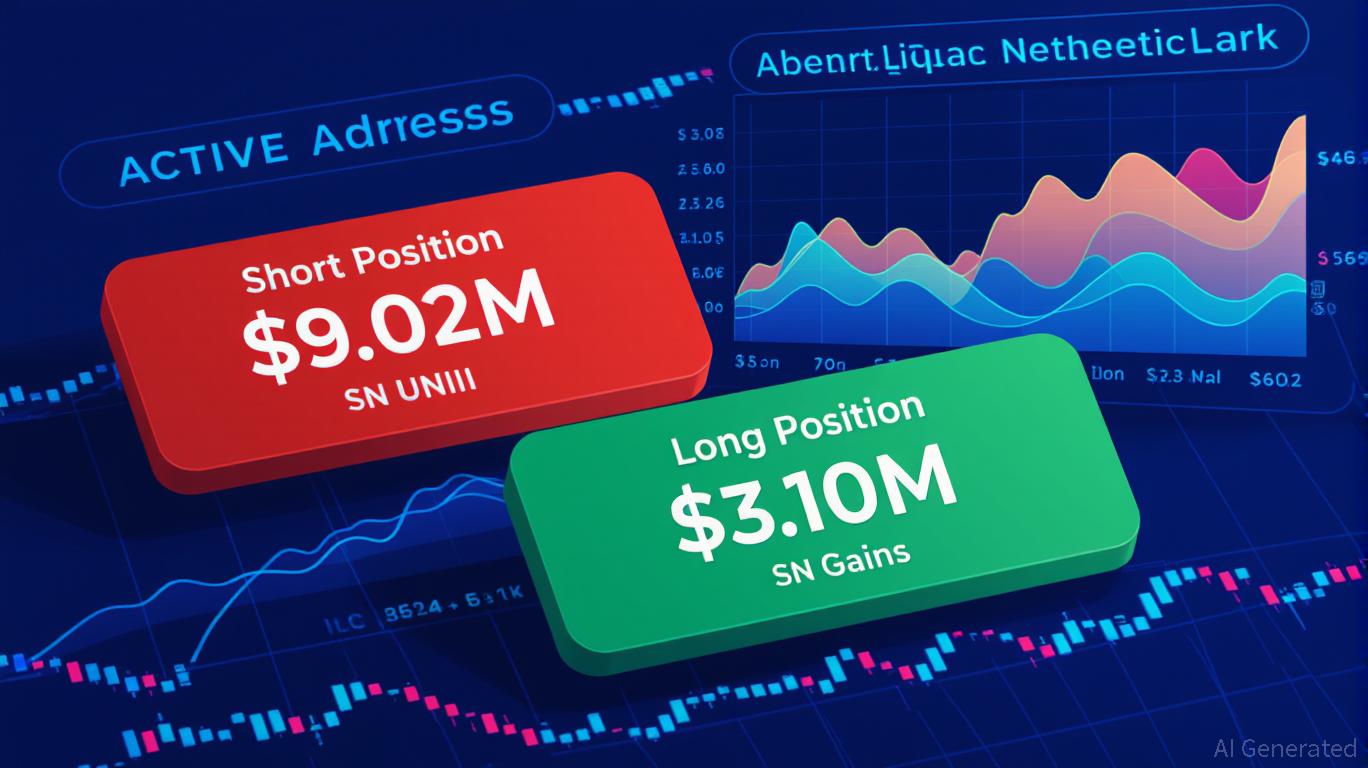Hyperliquid (HYPE) Price Rally: Increased On-Chain Engagement and Institutional Interest Drive Expansion Prospects
- Hyperliquid's HYPE token surged 32% driven by whale trading and institutional adoption via HIP-3 framework. - Whale activity shows $9M UNI short vs. $3.1M long positions, highlighting platform's speculative role in volatile assets. - Institutional partnerships with RedStone and Felix, plus 21Shares' ETF application, signal growing market confidence. - TVL reached $5B with 73% decentralized trading share, but regulatory gaps and leadership changes pose sustainability risks.
On-Chain Activity: Whales and Market Sentiment
Blockchain data from Hyperliquid in late 2025 reveals intense trading patterns. On November 11, a major holder (address 0xffb) initiated a $9.02 million short position on UNI with 10x leverage, making it the largest UNI short on the platform, according to
Rising transaction volumes and a growing number of active users further demonstrate Hyperliquid’s increasing traction. The platform’s fast execution and decentralized design have drawn in traders looking for streamlined derivatives trading, according to

Institutional Adoption: HIP-3 and Strategic Partnerships
Hyperliquid’s appeal to institutions is growing thanks to its HIP-3 protocol, which turns the platform into a permissionless system for launching new markets, as reported by
Institutional involvement has also grown through targeted collaborations. The HAUS partnership with DeFi protocol Felix allocated 500,000 HYPE tokens to support perpetual futures, generating returns for stakers, as detailed by
Hyperliquid’s total value locked (TVL) soared to $5 billion in the third quarter of 2025, accounting for 73% of decentralized perpetual trading activity, as reported by
Regulatory Challenges and Leadership Concerns
Despite these advances, Hyperliquid still faces significant obstacles. The lack of regulatory approval puts it at a disadvantage compared to licensed competitors like BlockchainFX, as highlighted in the
Conclusion: Balancing Opportunity and Risk
The recent rally in Hyperliquid’s price is the result of both on-chain momentum and growing institutional interest. Large trader activity highlights its status as a high-risk, high-reward trading venue, while HIP-3 and new partnerships set the stage for further adoption. Nevertheless, regulatory uncertainties and leadership changes remain key risks. For investors, the focus should be on how Hyperliquid manages these issues while leveraging its technological strengths.
Disclaimer: The content of this article solely reflects the author's opinion and does not represent the platform in any capacity. This article is not intended to serve as a reference for making investment decisions.
You may also like
Momentum (MMT) Soars Following Regulatory Approval – Could This Be the Trigger Retail Investors Have Anticipated?
- Momentum (MMT) surged 1,330% on Binance, driven by institutional support, airdrops, and favorable regulatory shifts. - U.S. CLARITY Act and EU MiCA 2.0 clarify digital commodity frameworks, reducing regulatory ambiguity for tokens like MMT . - Binance’s 7.5M MMT airdrop boosted retail participation, amplifying demand and liquidity in a maturing blockchain securities market. - MMT’s rapid rise highlights retail adoption potential but risks volatility amid evolving regulations and enforcement gaps.

Zcash News Today: Zcash's Surge Fueled by Privacy: Lasting Growth or Just Hype?
- Zcash (ZEC) surged 790% since October 2025, hitting a seven-year high of $627 but recently dropped to $488 amid volatility concerns. - Privacy demand and institutional adoption, including Ripple's $500M funding, fueled ZEC's rally as "encrypted Bitcoin" with zk-SNARK technology. - Market skepticism grows: $65M in ZEC futures liquidated, Polymarket odds for $1,000 target fell to 37%, and derivatives remain heavily shorted. - Project Tachyon aims to scale Zcash's throughput to 1,000+ private transactions/s
Solana News Update: Solana ETF Investments Face Off Against Negative Technical Signals at the $166 Turning Point
- Solana (SOL) faces mixed signals as ETF inflows wane despite short-term price rebounds, with $70M November inflows dropping to $6.78M by Nov 10. - Technical indicators show bearish bias: RSI near 40, MACD/AO below zero, and 50-day/100-day EMAs at $188-$190, suggesting $144 support risks. - Institutional confidence persists with $420M November inflows, but declining stablecoin liquidity (-8.16% to $13.8B) raises network depth concerns. - Ecosystem growth through DeFi and staking offsets bearish pressures,
Global AI Competition Sparks Data Center Boom: Companies Invest $2.35B in Modular Power Solutions
- APLD Compute Co raises $2.35B via secured notes to build North Dakota data centers and repay debt, aligning with AI/cloud demand growth. - Solaris Energy targets 2.2GW operated capacity by 2028, focusing on industrial data center power solutions amid rising GPU cluster energy needs. - Microsoft and Google commit $16B to expand European AI infrastructure, reflecting global competition for energy-efficient high-capacity facilities. - Array Digital reports 68% YOY site rental revenue growth but faces operat
